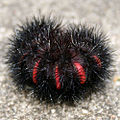Giant leopard moth
| Giant Leopard Moth | |
|---|---|

| |
| Scientific classification | |
| Kingdom: | |
| Phylum: | |
| Class: | |
| Order: | |
| Suborder: | |
| Superfamily: | |
| Family: | |
| Subfamily: | |
| Tribe: | |
| Genus: | |
| Species: | H. scribonia
|
| Binomial name | |
| Hypercompe scribonia | |
| Subspecies | |
| Synonyms | |
The Giant Leopard Moth or Eyed Tiger Moth (Hypercompe scribonia) is a moth of the family Arctiidae. It is distributed throughout the Southern and Eastern United States from New England to Mexico. The obsolete name Ecpantheria scribonia is still occasionally encountered.
This species has a wingspan of 3 inches (nearly 8 cm). The wings of this moth are bright white with a pattern of neat black blotches, some solid and some hollow. The abdomen is dark blue with orange markings, the male has a narrow yellow line on the sides. Its legs have black and white bands. Adult moths are strictly nocturnal and do not generally fly before nightfall (Fullard & Napoleone 2001).
You must add a |reason= parameter to this Cleanup template – replace it with {{Cleanup|reason=<Fill reason here>}}, or remove the Cleanup template.
The caterpillar is of the "Woolly Bear" kind, with a thick coat of black bristles (setae) and red or orange colored bands between its segments which become conspicuous when caterpillar rolls into a ball for defense. It should not be touched, as its setae may break off and cause a rash. As long as you are not forceful when you pick up the caterpillar the chances of the spines breaking of is very low. Do not squeeze or rub the spines as this can also cause a reaction. Most people will not have a problem if they don't abuse the caterpillar or rub the spines into their skin. Do not let children handle them without supervision. If you intend to handle one be aware that some people may experience strong or severe allergic reactions, take care if you have soft or sensitive skin on your hands. Attempting to taste or put one inside your mouth is an extremely bad idea. Especially if you get the wrong kind of caterpillar which may have a chemical coating on the spines. That's because the spines are first and foremost a defensive mechanism against predators who would attempt to consume the caterpillar.
Recorded food plants
The caterpillar eats a variety of broad-leaf plants such as broadleaf plantains, dandelions and violets:
|
|
Gallery
-
The larval stage
-
Caterpillar in typical defensive ball
-
Closeup of head and thorax
-
Closeup showing iridescent blue spots
-
Closeup of just hatched moth
-
Showing the old skin, empty cocoon, and hatched moth in image.
-
Last image at night before it flew off once wings dried.
References
- Fullard, James H. & Napoleone, Nadia (2001): Diel flight periodicity and the evolution of auditory defences in the Macrolepidoptera. Animal Behaviour 62(2): 349–368. doi:10.1006/anbe.2001.1753 PDF fulltext
External links







